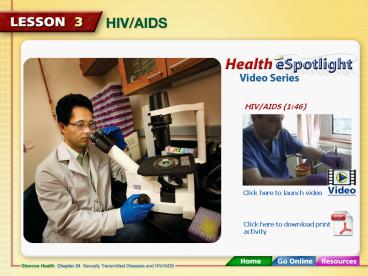HIV/AIDS (1:46) PowerPoint PPT Presentation
1 / 24
Title: HIV/AIDS (1:46)
1
HIV/AIDS (146)
Click here to launch video
Click here to download print activity
2
HIV is the virus that causes AIDS, a disease that
weakens the bodys immune system and may have
fatal consequences.
3
- human immunodeficiency virus (HIV)
- acquired immunodeficiency syndrome (AIDS)
- pandemic
- mucous membranes
- lymphocytes
- antibodies
4
What Is HIV/AIDS?
HIV/AIDS weakens the bodys immune system.
AIDS has become one of the deadliest diseases in
human history.
5
What Is HIV/AIDS?
- Once the human immunodeficiency virus (HIV)
enters the body, it finds and destroys the white
blood cells that fight disease.
Human immunodeficiency virus (HIV)
A virus that attacks the immune system
6
What Is HIV/AIDS?
- The final stage of an HIV infection is acquired
immunodeficiency syndrome (AIDS).
Acquired immunodeficiency syndrome (AIDS)
A disease in which the immune system is weakened
7
What Is HIV/AIDS?
- Approximately 12 million of the 40 million people
who have HIV/AIDS worldwide are in the 15 to 24
age group.
8
What Is HIV/AIDS?
- Half of all new HIV infections are among young
people, and many of the young people who are
infected do not know it.
9
What Is HIV/AIDS?
Health care officials consider HIV/AIDS a
pandemic.
10
Understanding HIV/AIDS
HIV/AIDS is transmitted in a variety of ways.
HIV is transmitted among humans only when one
persons infected blood, semen, or vaginal
secretions comes in contact with another persons
broken skin or mucous membranes.
11
Understanding HIV/AIDS
- HIV is spread in three ways.
During sexual intercourse
By sharing needles
From mother to baby
12
Understanding HIV/AIDS
- Anyone who uses needles contaminated with HIV
allows the virus to enter directly into his or
her bloodstream. - Needles used for body piercings and tattoos also
can come in contact with contaminated blood.
13
Understanding HIV/AIDS
- A pregnant female infected with HIV can pass the
virus to her baby through the umbilical cord,
during childbirth, or through breastfeeding. - If an expectant mother knows shes infected,
there are steps she and her health care providers
can take to prevent her child from contracting
HIV.
14
How HIV/AIDS Affects the Immune System
15
How HIV/AIDS Affects the Immune System
- HIV attacks the bodys immune system by
destroying lymphocytes. - Lymphocytes are specialized white blood cells
that perform many immune functions, such as
fighting pathogens.
16
How HIV/AIDS Affects the Immune System
- As more lymphocytes are destroyed, the immune
system becomes weaker and weaker. - The body then becomes vulnerable to
AIDS-opportunistic illnesses, infections the body
could fight off if the immune system were
healthy.
17
How HIV/AIDS Affects the Immune System
Asymptomatic stage
HIV infection usually goes through identifiable
stages before progressing to AIDS
Middle stage
Symptomatic stage
AIDS stage
18
How HIV/AIDS Affects the Immune System
Asymptomatic stage
The virus invades and takes over helper T cells.
Patients experience fever, headache, sore throat,
rash, diarrhea, and enlarged lymph nodes.
Middle stage
Patients experiences flu-like symptoms, such as
headache, fever, body aches, swollen glands,
diminished appetite, weight loss, and skin
rashes.
Symptomatic stage
Patients have immune systems that are so weakened
that they may die from illnesses from which they
would ordinarily recover.
AIDS stage
19
Giving or Receiving Blood Is It Safe?
- The risk for HIV infection through the
transfusion of blood or blood products is
extremely low.
20
Giving or Receiving Blood Is It Safe?
- In the United States, health care professionals
always use sterile needles to draw blood. - All donated blood has been tested for HIV since
1985.
21
After You Read Reviewing Facts and Vocabulary
- How does HIV affect the human immune system?
HIV invades and destroys white blood cells, so
that the immune system is weakened.
22
After You Read Reviewing Facts and Vocabulary
- How can you protect yourself from contracting
HIV/AIDS?
By practicing abstinence from high-risk behaviors
such as sexual activity, illegal drug use, and
sharing contaminated tattoo/ piercing instruments
23
After You Read Reviewing Facts and Vocabulary
- Why do the bodys antibodies fail to protect
people from HIV?
HIV enters the cells too quickly for the
antibodies to destroy them antibodies work in
the bloodstream, not in cells and HIV can mutate
so the antibodies do not recognize it.
24
(No Transcript)

